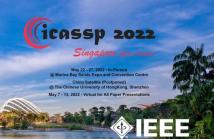
- Read more about A Novel Sequential Monte Carlo Framework For Predicting Ambiguous Emotion State (poster)
- Log in to post comments
- Categories:
 30 Views
30 Views
- Read more about A Novel Sequential Monte Carlo Framework For Predicting Ambiguous Emotion State (presentation slides)
- Log in to post comments
- Categories:
 22 Views
22 Views
- Read more about CNN-AIDED FACTOR GRAPHS WITH ESTIMATED MUTUAL INFORMATION FEATURES FOR SEIZURE DETECTION
- Log in to post comments
We propose a convolutional neural network (CNN) aided factor graphs assisted by mutual information features estimated by a neural network for seizure detection. Specifically, we use neural mutual information estimation to evaluate the correlation between different electroencephalogram (EEG) channels as features. We then use a 1D-CNN to extract extra features from the EEG signals and use both features to estimate the probability of a seizure event. Finally, learned factor graphs are employed to capture the temporal correlation in the signal.
- Categories:
 19 Views
19 Views
- Read more about CNN-AIDED FACTOR GRAPHS WITH ESTIMATED MUTUAL INFORMATION FEATURES FOR SEIZURE DETECTION
- Log in to post comments
- Categories:
 5 Views
5 Views
- Read more about Automatic Depression Detection: An Emotional Audio-Textual Corpus and a GRU/BiLSTM-based Model
- Log in to post comments
- Categories:
 31 Views
31 Views
- Read more about SleepGAN: Towards Personalized Sleep Therapy Music
- 1 comment
- Log in to post comments
8940_Yang.pdf
- Categories:
 39 Views
39 Views
- Read more about Entrainment Analysis for Assessment of Autistic Speech Prosody Using Bottleneck Features of Deep Neural Network
- Log in to post comments
In the present study, we quantify entrainment characteristics of conversation with the aim of automatic assessment of the severity of autism spectrum disorder (ASD). We focus on pairs of utterances immediate before and after turn-takings, which have prosodic/acoustic similarities.
- Categories:
 5 Views
5 Views
- Read more about Massive Unsourced Random Access Based on Bilinear Vector Approximate Message Passing Poster
- Log in to post comments
- Categories:
 14 Views
14 Views
- Read more about MASSIVE UNSOURCED RANDOM ACCESS BASED ON BILINEAR VECTOR APPROXIMATE MESSAGE PASSING presentation
- Log in to post comments
- Categories:
 26 Views
26 Views
- Read more about A KNOWLEDGE/DATA ENHANCED METHOD FOR JOINT EVENT AND TEMP RELATION EXTRACTIONORAL
- Log in to post comments
Understanding temporal relations (TempRels) between events is an important task that could benefit many downstream NLP applications. This task inevitably faces the challenges of both a limited amount of high-quality training data and a very biased distribution of TempRels. These problems will substantially hurt the performance of extraction systems because they are inclined to predict dominant TempRels when training with a limited amount of data.
- Categories:
 17 Views
17 Views